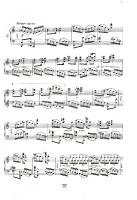Two Preludes for piano (1955)
In the summer of 1955, when he was still a pupil at the State Secondary School of Music in Warsaw, Tomasz Sikorski composed Five Preludes for piano. Two of them were later published by PWM Edition, which must have caused a big stir as well as envy among his school friends. Two Preludes is Sikorski’s first “adult” composition, although the composer was still underage when it was completed and published.
Two Preludes can be listed among neoclassical works with a distinct form, clear musical narrative and traditional piano texture. Its two small parts (the whole occupies just four pages) are well balanced both internally and with regard to each other.
The first prelude consists of three sections. The outer sections – Andante non troppo – are lyrical, somewhat meditative and written in triple metre. The driver of the contrasting middle section, Allegro, in 4/4 metre is an even pulse of quaver triplets, which is the basis of the work’s dramaturgy culminating in the final, fast rising progression (furioso). The second prelude – single-section Allegro agitato – is a showy piece full of energy, contrasts and constant changes of metre. It gives the pianist a great opportunity to show his or her personality, stage persona and technical skills.
This is what Ewa Grosman wrote about Two Preludes:
Sikorski’s first pieces reveal his pianistic pedigree as well as knowledge of technique and specificity of the instrument. There are also elements of virtuosity that will disappear in later pieces, ousted by his interest in sound and its sustain. Musical progression is still traditionally shaped by a search for culmination and release, but we can already find here repetitions of one basic motif, which in this case is justified in the use of the prelude form.

